
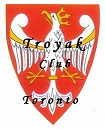
TROYAK EXECUTIVE TEAM is informing all members, colleagues, collectors, and Polonia at large, that Club meetings taking place at John Paul II Polish Cultural Centre, 4300 Cawthra Rd. (just south of Hwy. 403), Mississauga, Ontario. The new members are always welcome. www.polishculturalcentre.ca
ADRES SPOTKAÑ KLUBOWYCH ! Zarząd Główny Klubu “Troyak” informuje wszystkich członków kolekcjonerów, sympatyków oraz całą Polonię, że spotkania klubowe odbywają się w Polskim Centrum Kultury im. Jana Pawła II, przy 4300 Cawthra Rd. (na południe od autostrady 403), Mississauga, Ontario. Zapraszamy nowych członków do prężnego. Klubu “Troyak”. www.polishculturalcentre.ca

“TROYAK” CLUB NEXT MEETINGS …
NASTĘPNE SPOTKANIA KLUBU “TROYAK” …
28th February 2021 @ 4:30 p.m. … via ZOOM

28th March 2021 … via ZOOM
25th April 2021
30th May 2021; 27th June 2021
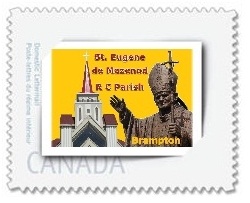
July & August 2021 – Summer break … Letnie wakacje …

26th September 2021;
31st October 2021 @ 4:30 p.m.
28th November 2021
December 2021 @ Happy Holidays !

Motyle
Butterflies
www.poczta-polska.pl
W dniu 8 października 2020 r. roku zostały wprowadzone do obiegu 4 znaczki pocztowe o wartości 3,30 zł emisji “Motyle”. Na poszczególnych znaczkach przedstawiono motyle z Ameryki Południowej i Środkowej: *** 1) na pierwszym – motyla Ameryki Środkowej, Danaus plexippus, wzdłuż lewej krawędzi znaczka umieszczono nazwę motyla: Danaus plexippus, a wzdłuż górnej krawędzi nazwę emisji: Motyle, *** 2) na drugim – motyla Ameryki Południowej, Agrias narcissus, wzdłuż lewej krawędzi znaczka umieszczono nazwę motyla: Agrias narcissus, a wzdłuż górnej krawędzi nazwę emisji: Motyle, *** 3) na trzecim – motyla Ameryki Południowej, Morpho helene, wzdłuż lewej krawędzi znaczka umieszczono nazwę motyla: Morpho helene, a wzdłuż górnej krawędzi nazwę emisji: Motyle, *** 4) na czwartym – motyla Ameryki Południowej, Morpho portis, wzdłuż lewej krawędzi znaczka umieszczono nazwę motyla: Morpho portis, a wzdłuż górnej krawędzi nazwę emisji: Motyle. W prawym dolnym rogu znaczków wymienionych w ust. 2 umieszczono napis: POLSKA, a w lewym górnym rogu oznaczenie ich wartości 3,30 ZŁ. Znaczki wydrukowano techniką offsetową, na papierze fluorescencyjnym, w formacie 45 x 45 mm, w nakładzie 168 000 szt. każdego. Arkusz sprzedażny zawiera 8 znaczków. Z tej okazji zostaną wydane 4 koperty FDC. Autor projektu: Andrzej Gosik.
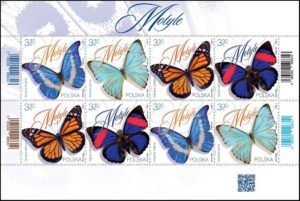
Butterflies … denomination: 3,30 PLN;
number of stamps in set: 4; print run: 168.000;
printing techniques: offset; paper: fluorescent;
stamp size: 45 x 45 mm; author: Andrzej Gosik;
number of FDC: 4; circulation date: 08th October 2020.
Poczta Polska: najpiękniejsze motyle na znaczkach pocztowych … Na czterech znaczkach przedstawiono najpiękniejsze gatunki motyli pochodzące z Ameryki Środkowej i Południowej. Najnowsza seria filatelistyczna Poczty Polskiej została uroczyście wprowadzona do obiegu 8 października 2020 r. w Miejskim Ogrodzie Zoologicznym w Warszawie. Jednocześnie otwarto nową atrakcję dla gości warszawskiego ZOO – wystawę egzotycznych motyli, która – ze względu na krótki okres życia tych pięknych owadów – trwała tylko do 25 października 2020 r.
Poczta Polska wydając znaczki z motylami chce zwrócić uwagę na problem ginących gatunków. Spółka w ramach społecznej odpowiedzialności biznesu przypomina swoimi wydawnictwami filatelistycznymi o ważnych wydarzeniach historycznych, postaciach, ale też ważnych społecznie tematach. Populacja owadów, a w szczególności bardzo wrażliwych na zmiany motyli na całym świecie zmniejsza się, nie tylko w lasach Amazonii w wyniku wycinania lasów tropikalnych, ale także w Polsce. Sadząc lubiane przez motyle rośliny możemy przyczynić się do odbudowania ich populacji. Takimi roślinami są m.in.: malina, krokus, rumianek, mięta.
Autor projektu znaczków, Andrzej Gosik, przedstawił na nich cztery motyle pochodzące z Ameryki Południowej i Środkowej: Morpho Portis, Morpho Helena, Donaus Plexippus oraz Agrias Narcissus. Znaczki okolicznościowe, w nakładzie 168 tys. każdego, trafiły do obiegu 8 października 2020 r. Oprócz znaczków Poczta Polska wydała, w limitowanej wersji, koperty FDC, czyli koperty Pierwszego Dnia Obiegu. Widnieją na nich ilustracje skrzydeł motyli.
Znaczki okolicznościowe wprowadzono do obiegu 8 października 2020 r. podczas konferencji z udziałem Mateusza Wodejko, wiceprezesa zarządu Poczty Polskiej oraz dr. Andrzeja G. Kruszewicza, dyrektora Miejskiego Ogrodu Zoologicznego w Warszawie. Uroczystość wprowadzenia znaczków uświetniła otwarcie nowej atrakcji warszawskiego ZOO, w którym pojawili się nowi mieszkańcy – bajecznie piękne motyle. W Pawilonie Bezkręgowców dostępna była dwutygodniowa ekspozycja pt.: „Motyle ginących dżungli – ulotne piękno”. Zwiedzający mogli obejrzeć 8 gatunków egzotycznych motyli pochodzących z różnych regionów świata. Wystawa to jesienny prezent dla gości Warszawskiego ZOO od Fundacji PANDA, która na przestrzeni lat już po raz trzeci umożliwia gościom podziwianie motyli.
Nowi mieszkańcy ZOO już zaczęli się wykluwać. W Pawilonie Bezkręgowców zainstalowano specjalny inkubator, dzięki czemu można było obserwować jak niepozorne poczwarki zamieniają się w barwne motyle. Żywot motyli jest jednak krótki, więc warto było skorzystać z okazji i oglądać je w Warszawskim ZOO między 8 a 25 października. Na świecie żyje około 150 tysięcy gatunków motyli, z czego w Polsce ponad 3 tysiące. Występują na wszystkich kontynentach, oprócz Antarktydy. Należą do najbardziej zaawansowanych ewolucyjnie owadów.

Światowy Dzień Znaczka Pocztowego
www.poczta-polska.pl
9 października 2020 r. obchodziliśmy Światowy Dzień Znaczka Pocztowego oraz Światowy Dzień Poczty. Każdego roku Poczta Polska oddaje w ręce klientów i filatelistów wiele wspaniałych wydawnictw, które edukują, przypominają o najważniejszych wydarzeniach i postaciach, upamiętniają wielkie rocznice oraz zapełniają ludzką potrzebę obcowania z kulturą czy sztuką. Minione lata obfitowały w rozmaite projekty, które wzbudzały wielkie zainteresowanie wśród kolekcjonerów oraz osób wykorzystujących znaczek, jako potwierdzenie opłaty pocztowej. Poruszane na małych dziełach sztuki, jakimi bez cienia wątpliwości są walory filatelistyczne, tematy wzbudzały emocje, wzruszały, bawiły, pozwalały na chwilę refleksji – prawie nikt nie pozostawał wobec nich obojętny.
– Chciałbym w tym miejscu wyrazić słowa najwyższego uznania dla wszystkich filatelistów, dla ich wkładu w popularyzację największych wartości wyrażanych poprzez codzienną pracę w poszukiwaniu i gromadzeniu śladów naszej historii zawartych w małych dziełach sztuki, jakimi są znaczki pocztowe – powiedział Wiesław Włodek, wiceprezes zarządu Poczty Polskiej.
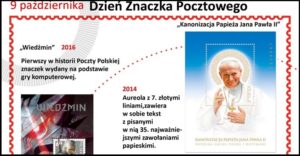
Znaczek pocztowy to podstawowy środek uiszczania opłat za usługi pocztowe. Jego historia sięga roku 1840, kiedy to dzięki nauczycielowi i urzędnikowi poczty królewskiej Wielkiej Brytanii Rowlandowi Hill’owi wprowadzono do obiegu pierwszy znaczek pocztowy tzw. Black Penny o wartości 1 pensa z wizerunkiem młodej królowej Wiktorii. Było to zdarzenie epokowe do tego stopnia, że wkrótce inne kraje wprowadziły znaczek jako dowód wniesienia opłaty za usługi przewozu i doręczenia korespondencji.
Minęło zaledwie 20 lat gdy jako 12. administracja pocztowa na świecie również ówczesne Królestwo Polskie wyemitowało swój pierwszy znaczek pocztowy. Warto dodać, że było to kilkanaście lat wcześniej niż uczyniły to Włochy, Japonia czy Niemcy. To jednocześnie pierwszy oficjalnie uznany polski znaczek pocztowy. Przez następne lata znaczki pocztowe pełniły swoją praktyczną rolę jako świadectwo opłat za usługi błyskawicznie rozwijającego się rynku pocztowego, stając się niepostrzeżenie jedną z najważniejszych pasji zbieraczy wśród setek milionów ludzi na świecie.
W tym 2020 roku obchodzimy również Światowy Dzień Poczty ustanowiony 9 października 1969 roku dla upamiętnienia podpisania Traktatu Berneńskiego powołującego Światowy Związek Pocztowy. Pocztowcy w Polsce obchodzą swoje święto 18 października na pamiątkę ustanowienia pierwszego połączenia pocztowego przez króla Zygmunta II Augusta w 1558 roku.

12 Gwiazd w Koronie Królowej Pokoju
12 Stars in the Crown of the Queen of Peace
www.poczta-polska.pl
Dnia 13 października 2020 r. został wprowadzony do obiegu znaczek pocztowy o wartości 3,30 zł emisji “12 Gwiazd w Koronie Królowej Pokoju “. Na znaczku przedstawiono rzeźbę znajdująca nad ołtarzem w Kaplicy Wieczystej Adoracji Najświętszego Sakramentu w Niepokalanowie. W lewym górnym rogu znaczka umieszczono oznaczenie ich wartości: 3,30 ZŁ i napis: POLSKA oraz ,,M. Dabrowska”, a w prawym dolnym rogu – napis: 12 Gwiazd w Koronie Królowej Pokoju oraz ,,Gwiazda Niepokalanej – Drapikowski Studio”. Znaczek wydrukowano techniką offsetową, na papierze fluorescencyjnym, w formacie: 31,25 x 43 mm, w nakładzie 180 000 sztuk. Arkusz zawiera 12 szt. znaczków. Z tej okazji została wydana również koperta FDC. Autor projektu: Marzanna Dąbrowska.

12 Stars in the Crown of the Queen of Peace …
denomination: 3,30 PLN; number of stamps in set: 1;
print run: 180.000; printing techniques: offset;
paper: fluorescent; stamp size: 31,25 x 43 mm;
number of FDC: 1; author: Marzanna Dąbrowska;
circulation date: 13th October 2020.

150 lat Muzeum Polskiego w Rapperswilu
150 years of the Polish Museum in Rapperswil
www.poczta-polska.pl
Dnia 23 października 2020 r. został wprowadzony do obiegu znaczek pocztowy o wartości 4,00 zł emisji “150 lat Muzeum Polskiego w Rapperswilu”. Na znaczku przedstawiono Kolumnę Barską – pomnik w kształcie kolumny z orłem na szczycie, który powstał z inicjatywy Władysława Platera, założyciela Muzeum Polskiego w Rapperswilu. Na kopercie FDC oraz datowniku przedstawiony został średniowieczny zamek w Rapperswilu, w Szwajcarii – siedziba Muzeum Polskiego od 1870 roku, który niedawno odnowiono staraniem Bröel-Platera. Znaczek wydrukowano techniką offsetową, na papierze fluorescencyjnym, w formacie: 31,25 x 43 mm, w nakładzie 135 000 sztuk. Arkusz zawiera 9 szt. znaczków. Z tej okazji została wydana również koperta FDC. Autor projektu: Poczta Polska S.A.
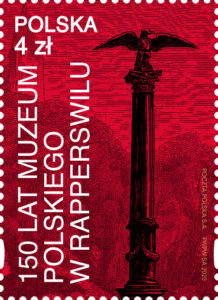
150 years of the Polish Museum in Rapperswil …
denomination: 4,00 PLN; number of stamps in set: 1;
print run: 135.000; printing techniques: offset;
paper: fluorescent; stamp size: 31,25 x 43 mm;
number of FDC: 1; author: Poczta Polska S.A.
circulation date: 23rd October 2020.
– Historia Muzeum podziela i skupia w sobie, jak w soczewce, los polskiego narodu na przestrzeni ostatniego półtorawiecza. W zamyśle twórców miała to być instytucja kultywująca rangę Rzeczypospolitej, będąca wizytówką polskiej kultury. Już samo założenie i utrzymanie Muzeum Narodowego Polskiego, taką nazwę otrzymało w 1870 r., na obczyźnie, przez emigrantów, bojowników dwóch zakończonych klęską powstań narodowych, a jednak zdolnych do finansowego i organizacyjnego wysiłku, budziło podziw i szacunek – mówi Anna Buchmann, dyrektor Muzeum. – Gromadzenie, przechowywanie i udostępnianie zbiorów były w Muzeum zawsze środkiem do realizacji wyższych celów. Niezależnie od okoliczności, Muzeum było dla Polaków ostoją. Żadne inne mniejszości narodowe w Szwajcarii nie stworzyły tak trwałej, własnej instytucji kulturalnej – podkreśla Anna Buchmann.
Muzeum Polskie w Rapperswilu zostało założone w 1870 roku przez polityka emigracyjnego hrabiego Władysława Bröel-Platera, w czasach, kiedy w wyniku rozbiorów Polska zniknęła z mapy Europy. Inicjatorem przedsięwzięcia był Agaton Giller – dziennikarz i działacz niepodległościowy. Głównymi powodami powstania Muzeum były zabezpieczenie polskich zabytków historycznych oraz propagowanie spraw polskich. Dotychczas w bibliotece zgromadzono ponad 35 000 książek, przede wszystkim poloników, 596 starodruków i ponad 1000 rycin. Kolekcja map dawnej Polski należy w chwili obecnej do najliczniejszej poza granicami Polski. Zbiór spuścizn i zespołów archiwalnych wciąż służy badaczom historii i kultury w Szwajcarii i w Polsce.

Armia Andersa – Szlak Nadziei
Army of Anders – Trail of Hope
www.poczta-polska.pl
W dniu 28 października 2020 został wprowadzony do obiegu znaczek pocztowy o wartości 4,00 zł emisji “Armia Andersa – Szlak Nadziei”. Na znaczku przedstawiono postać gen. Władysława Andersa oraz poniżej defiladę żołnierzy. W lewym górnym rogu znajduje się logo Fundacji Wspólnota Andersa ,,WA”. Wzdłuż górnej części znaczka umieszczono napisy: POLSKA i ARMIA ANDERSA – SZLAK NADZIEI oraz oznaczenie wartości 4 ZŁ. Znaczek wydrukowano techniką offsetową, na papierze fluorescencyjnym, format znaczka: 39,5 x 31,25 mm, w nakładzie 144.000 szt. Arkusz sprzedażny zawiera 12 znaczków (tete-beche). Z tej okazji została wydana również koperta FDC. Autor projektu: Andrzej Gosik.
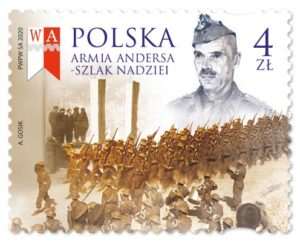
Army of Anders – Trail of Hope … denomination: 4,00 PLN;
number of stamps in set: 1 (12 in sheet, tete-beche);
print run: 144 000 pcs; printing techniques: offset;
paper: fluorescent; stamp size: 39,5 x 31,25 mm;
number of FDC: 1; author: Andrzej Gosik;
circulation date: 28th October 2020.
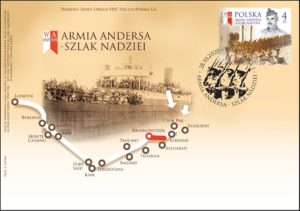

80. Rocznica bitwy o Anglię
80th Anniversary of the Battle of England
www.poczta-polska.pl
W dniu 28 października 2020 został wprowadzony do obiegu znaczek pocztowy o wartości 8,70 zł, emisji “80. rocznica bitwy o Anglię”. Na znaczku przedstawiono rekonstrukcję brytyjskiego samolotu myśliwskiego Hawker Hurricane Mk1 o numerze bocznym P3700, który brał udział w bitwie o Anglię w 303 Dywizjonie Myśliwskim Polskich Sił Powietrznych w Wielkiej Brytanii. W prawym dolnym rogu znaczka umieszczono napisy: POLSKA oraz 80. ROCZNICA BITWY O ANGLIĘ, a w lewym dolnym rogu – oznaczenie wartości 8,70 ZŁ. Znaczki wydrukowano techniką offsetową, na papierze fluorescencyjnym, format znaczka: 43 x 31,25 mm, format bloku: 90 x 70 mm, w nakładzie 90.000 szt. Z tej okazji została wydana koperta FDC, na której przedstawiono flagi Polski i Wielkiej Brytanii. Autor projektu: Jarosław Ochendzan.

80th Anniversary of the Battle of England …
denomination: 8,70 PLN; number of stamps in set: 1;
print run: 90 000 pcs each; printing techniques: offset;
paper: fluorescent; stamp size: 43 x 31,25 mm;
number of FDC: 1; author: Jarosław Ochendzan;
circulation date: 28th October 2020.
Bitwa o Anglię była kampanią powietrzną, toczoną w 1940 roku nad terytorium południowej i centralnej Anglii, między brytyjskim lotnictwem – RAF, niemieckim – Luftwaffe w czasie II. Wojny Światowej. Była to pierwsza kampania toczona wyłącznie z wykorzystaniem lotnictwa. W Bitwie o Anglię walczyły 4 polskie dywizjony oraz 81 pilotów z Polski za sterami brytyjskich jednostek powietrznych. Polacy zestrzelili lub uszkodzili ponad 200 niemieckich samolotów, co stanowiło około 12% ogólnych strat Luftwaffe w trakcie starć nad Wielką Brytanią. Najbardziej znaną i efektywną polską jednostką biorącą udział w Bitwie o Anglię był 303 Dywizjon Myśliwski Warszawski im. Tadeusza Kościuszki – około 60 trafień. Bohaterstwo Dywizjonu zostało upamiętnione m.in. w książkach, pomnikach, a także filmach fabularnych. Poczta Polska dokłada kolejną cegiełkę w tym zakresie kultywując pamięć i tradycję.
– Poczta Polska swoją serią filatelistyczną upamiętnia szlak bojowy gen. Władysława Andersa, pamiętamy także o 80. rocznicy Bitwy o Anglię. Jesteśmy dumni z dokonań polskich żołnierzy walczących daleko od ojczystych ziem. Poczta Polska pełniąc swoją misję społeczną czuje się w obowiązku przypominać o polskich bohaterach i wydarzeniach, które na trwałe zapisały się na kartach historii Polski i świata – mówi Wiesław Włodek, wiceprezes zarządu Poczty Polskiej.
Na trzecim już z serii znaczków poświęconych Armii Władysława Andersa autor projektu, Andrzej Gosik, przedstawił postać generała oraz defiladę żołnierzy. W lewym górnym rogu znalazło się logo Fundacji Wspólnota Andersa „WA”. Na kopercie Pierwszego Dnia Obiegu widnieje natomiast fotografia z marca 1942 roku, przedstawiająca ewakuację Armii Andersa ze Związku Sowieckiego. Wybuch II wojny światowej we wrześniu 1939 r. oznaczał podział Polski między Niemcy i Związek Socjalistycznych Republik Sowieckich, zgodnie z zawartym 23 sierpnia 1939 r. paktem Ribbentrop-Mołotow. Po agresji Niemiec na ZSRS w czerwcu 1941 r. rozpadł się sojusz Hitler-Stalin, co diametralnie zmieniło sytuację polityczną w Europie. Setki tysięcy Polaków zesłanych po wrześniu 1939 r. w głąb terytorium wschodniego najeźdźcy, mogło – w wyniku układu Sikorski-Majski z 30 lipca 1941 r. – zostać zwolnionych z więzień i obozów na terenach ZSRS i wejść w skład tworzonych tam Polskich Sił Zbrojnych. Na ich czele stanął generał Władysław Anders.
Dzięki tej armii ocalono dziesiątki tysięcy Polaków, którzy uzyskali nadzieję na wolność własną i Polski. Tworzenie polskiego wojska w ZSRS oznaczało pokonanie wielu problemów organizacyjnych. Na szlaku Armii Andersa żołnierzom towarzyszył kapral niedźwiedź Wojtek, jego postać Poczta Polska także upamiętniła znaczkiem wydanym w 2017 roku.

100 lat polskiego szkolnictwa morskiego 1920-2020
100 years of Polish maritime education 1920-2020
www.poczta-polska.pl
Dnia 30 października 2020 r. została wprowadzona do obiegu kartka pocztowa z nadrukowanym znakiem opłaty pocztowej, emisji: 100 lat polskiego szkolnictwa morskiego 1920-2020. Wartość nominalna znaku opłaty pocztowej z oznaczeniem literowym A odpowiada wartości nominalnej znaczka pocztowego używanego do uiszczenia opłaty za ekonomiczną przesyłkę listową nierejestrowaną, w tym kartkę pocztową, w obrocie krajowym, w formacie S o masie do 500 g. W prawym górnym rogu strony adresowej kartki nadrukowano znak opłaty pocztowej, na którym przedstawiono zdjęcie Kazimierza Porębskiego. W lewym górnym rogu znaczka umieszczono napis: POLSKA, a wzdłuż dolnej krawędzi napis: WICEADMIRAŁ KAZIMIERZ PORĘBSKI oraz oznaczenie wartości: A. W części ilustracyjnej kartki znajduje się grafika przedstawiająca Żaglowiec STS Lwów z 1920 r. Kartki o wymiarach 148 x 105 mm wydrukowano jednostronnie, techniką offsetową, na kartonie białym, w nakładzie 8000 sztuk. Autor projektu kartki: Jarosław Ochendzan.

100 years of Polish maritime education 1920-2020 …
denomination: 3,30 PLN; number of stationeries in set: 1;
print run: 8.000 pcs; printing technique: offset;
card size: 148 x 105 mm; author: Jarosław Ochendzan;
release date: 30th October 2020.

Wielkie aktorki – Antonina Hoffmann
www.nbp.pl
Narodowy Bank Polski jest centralnym bankiem państwa odpowiadającym za politykę pieniężną i stabilność cen. Jego funkcje określa Konstytucja Rzeczypospolitej Polskiej i ustawa o NBP. NBP ma wyłączne prawo emisji pieniądza. Jako bank centralny nie prowadzi rachunków bankowych obywateli, nie przyjmuje od nich lokat, nie udziela kredytów. Prowadzi natomiast obsługę budżetu państwa, a także podmiotów sektora finansów publicznych. Gromadzi rezerwy walutowe państwa i zarządza nimi. Pełni funkcję banku banków, tworząc warunki do działania systemu bankowego. Jest również jednym z najważniejszych ośrodków naukowo-analitycznych w dziedzinie ekonomii i rynków finansowych. 27 października 2020 roku Narodowy Bank Polski wprowadził do obiegu srebrną monetę o nominale 20 zł z serii „Wielkie aktorki” – „Antonina Hoffmann”.

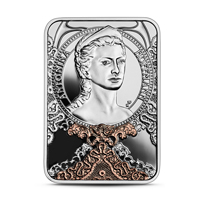
Nominał 20 zł … metal: Ag 925/1000; stempel: lustrzany, selektywne platerowanie; wymiary: 40,00 × 28,00 mm; masa: 28,28 g; brzeg (bok): gładki; nakład: do 13 000 szt.; Projektant: Urszula Walerzak; Emitent: NBP; Na zlecenie NBP monety wyprodukowała Mennica Polska S.A.
Antonina Hoffmann (ur. 16.06.1842 r. w Trzebini – zm. 16.06.1897 r. w Krakowie) była wybitną, krakowską aktorką teatralną przełomu XIX i XX w. Obdarzona talentem i urodą, w ciągu niemal czterdziestoletniej kariery zagrała ponad czterysta ról. Występowała w utworach klasycznych, m.in. w dramatach W. Szekspira i F. Schillera, odnosiła sukcesy w komediach i współczesnych dramatach obyczajowych. Jednak najwyżej ceniono jej liczne role w dramatach J. Słowackiego – Amelię w Mazepie, Rozę w Lilli Wenedzie, Idalię w Fantazym, Salomeę w Horsztyńskim, tytułowe bohaterki w Balladynie i Beatrix Cenci i inne. Pochodziła ze zubożałej, ewangelickiej rodziny ziemiańskiej. Młodość spędziła w Warszawie, gdzie ukończyła pensję dla dziewcząt, którą po sprzedaniu majątku kierowała jej matka. Wbrew woli bliskich postanowiła poświęcić życie teatrowi. Po kilku lekcjach u wybitnego aktora Jana Królikowskiego zapisała się do Szkoły Dramatycznej i jako uczennica debiutowała 13.02.1859 r. w Warszawskich Teatrach Rządowych.
W 1860 r. przeniosła się do Krakowa. Szybko osiągnęła status czołowej aktorki. Została przyjaciółką i zarazem rywalką sceniczną Heleny Modrzejewskiej. Często występowały razem, wymieniały się doświadczeniami, uczyły się wzajemnie sztuki aktorskiej. W 1861 r. Hoffmann została partnerką życiową Stanisława Koźmiana – przedstawiciela obozu Stańczyków (ugrupowania politycznego w Galicji), od 1871 r. wieloletniego kierownika artystycznego krakowskiego teatru. Koźmian był twórcą tzw. krakowskiej szkoły aktorstwa, polegającej m.in. na eliminowaniu sztuczności i doskonaleniu gry zespołowej. Główną reprezentantką tego nowoczesnego stylu była właśnie Hoffmannowa – jej aktorstwo było powściągliwe, dalekie od deklamacji i gwiazdorstwa. Pod koniec kariery artystka została zaangażowana przez dyrektora Tadeusza Pawlikowskiego do otwartego 21.10.1893 r. Teatru Miejskiego w Krakowie (obecnie Teatr im. Juliusza Słowackiego). Z tą sceną, jedną z najlepszych na ówczesnych ziemiach polskich, Antonina Hoffmann była związana do końca życia. Na rewersie monety umieszczono popiersie Antoniny Hoffmann według rzeźby autorstwa Władysława Eliasza z 1872 r. oraz wizerunki koronek nawiązujące do kostiumów scenicznych aktorki. Na awersie został zaprezentowany wizerunek frontonu Teatru im. Juliusza Słowackiego w Krakowie. Informacja: Diana Poskuta-Włodek.

Great Actresses – Antonina Hoffmann
www.nbp.pl
Narodowy Bank Polski is the central bank of the State, responsible for its monetary policy and price stability. The Bank’s functions are described in the Constitution of the Republic of Poland and the Act on NBP. NBP holds the exclusive right to issue the currency of the Republic of Poland. As the central bank, it does not provide accounts for the general public, accept deposits from or extend loans to individuals. It acts as a banker to the State budget and public sector entities. NBP also holds and manages the foreign exchange reserves of the State. Finally, it functions as a banker to banks, creating conditions for the operation of the Polish banking system. Narodowy Bank Polski is one of the most important research and analytical centres in the fields of economics and financial markets. On 27 October 2020, Narodowy Bank Polski issued into circulation a silver coin of the series ”Great Actresses” – Antonina Hoffmann, with a face value of 20 złoty.


Face value 20 zł … Metal: Ag 925/1000; Finish: proof, selective plating; Dimensions: 40.00 × 28.00 mm; Weight: 28.28 g; Edge (side): plain; Mintage: up to 13,000 pcs; Coin designer: Urszula Walerzak; Issuer: NBP; The coins, commissioned by NBP, were struck by Mennica Polska S.A.
Antonina Hoffmann (born 16 June 1842 in Trzebinia – died 16 June 1897 in Kraków) was an outstanding theatre actress in Kraków at the turn of the 19th and 20th centuries. Endowed with talent and looks, she played over four hundred roles during her acting career that spanned nearly four decades. She performed in classical repertoire plays, among others, dramas by William Shakespeare and Friedrich Schiller, she was successful in comedies and contemporary social dramas. However, she won acritical acclaim for her numerous roles in Juliusz Słowacki’s dramas – as Amelia in Mazepa, Roza in Lilla Weneda, Idalia in Fantazy, Salomea in Horsztyński, and title roles in Balladyna and Beatrix Cenci and others. Hoffmann hailed from an impoverished, evangelical landowning family. In her youth, she attended a finishing school for girls in Warsaw, which was managed by her mother after the latter sold her estate. Against the wishes of her family, she decided to dedicate her life to the stage. After taking a few private acting lessons from an outstanding actor Jan Królikowski, she enrolled at the School of Drama where she made her debut, while still a student, in the Warsaw government theatres on 12 February 1859.
In 1860, Hoffmann moved to Kraków where she quickly became the leading actress. She became the friend and a stage rival of Helena Modrzejewska. They often acted together, exchanged their experiences, and learned the tricks of the trade from each other. In 1861, Hoffmann became a lifelong partner of Stanisław Koźmian – a member of the Stańczycy (a Galician political party). From 1871, he was a long-time artistic director of a Kraków theatre. He created the so-called ”Kraków School” of acting, a method in which actors did away with artificiality and honed team acting skills. Hoffmann was an exponent of this modern style – her acting was restrained, a far cry from declamation and stardom. Towards the end of her career, she was hired by theatre director Tadeusz Pawlikowski to the Kraków Municipal Theatre (currently the Juliusz Słowacki Theatre in Kraków) which opened on 21 October 1893. She would perform on this stage, one of the best theatres in contemporary Poland, for the rest of her life. The reverse of the coin shows the bust of Antonina Hoffmann from the 1872 sculpture by Władysław Eliasz and images of laces from her stage costumes. The obverse of the coin includes the image of the facade of the Juliusz Słowacki Theatre in Kraków. Info: Diana Poskuta-Włodek.

Stulecie odzyskania przez Polskę niepodległości
– Wincenty Witos
www.nbp.pl
Narodowy Bank Polski jest centralnym bankiem państwa odpowiadającym za politykę pieniężną i stabilność cen. Jego funkcje określa Konstytucja Rzeczypospolitej Polskiej i ustawa o NBP. NBP ma wyłączne prawo emisji pieniądza. Jako bank centralny nie prowadzi rachunków bankowych obywateli, nie przyjmuje od nich lokat, nie udziela kredytów. Prowadzi natomiast obsługę budżetu państwa, a także podmiotów sektora finansów publicznych. Gromadzi rezerwy walutowe państwa i zarządza nimi. Pełni funkcję banku banków, tworząc warunki do działania systemu bankowego. Jest również jednym z najważniejszych ośrodków naukowo‑analitycznych w dziedzinie ekonomii i rynków finansowych. Emisja wartości kolekcjonerskich stanowi okazję do upamiętniania ważnych historycznych rocznic i postaci oraz do rozwijania zainteresowań polską kulturą, nauką i tradycją. 5 listopada 2020 roku Narodowy Bank Polski wprowadził do obiegu srebrną monetę o nominale 10 zł oraz złotą monetę o nominale 100 zł z serii „Stulecie odzyskania przez Polskę niepodległości” – „Wincenty Witos”.
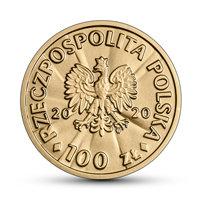
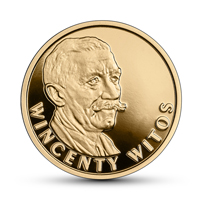
Nominał 100 zł … metal: Au 900/1000; stempel: lustrzany; średnica: 21,00 mm; masa: 8,00 g; obrzeże (bok): napis: Stulecie odzyskania przez Polskę niepodległości; nakład: do 1200 szt.
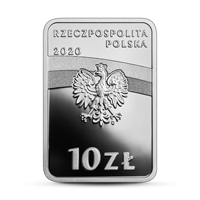

Nominał 10 zł … metal: Ag 925/1000; stempel: lustrzany; wymiary: 32,00 × 22,40 mm; masa: 14,14 g; obrzeże (bok): gładkie; nakład: do 11 000 szt. ; Projektant: Dobrochna Surajewska; Emitent: NBP; Na zlecenie NBP monety wyprodukowała Mennica Polska S.A. Portret Wincentego Witosa znajdujący się na rewersie monety srebrnej został zaprojektowany na podstawie zdjęcia Wincentego Witosa pochodzącego z zasobów Archiwum Akt Nowych.
Wincenty Witos (1874–1945) – polityk, publicysta; trzykrotny premier II RP; przywódca Polskiego Stronnictwa Ludowego „Piast” i Stronnictwa Ludowego; członek Ligi Narodowej, jeden z ojców niepodległości. Urodził się w Wierzchosławicach w chłopskiej rodzinie. W szkole elementarnej dał się poznać jako zdolny uczeń, jednak z racji słabej kondycji finansowej rodziny nie mógł się dalej kształcić; został samoukiem, czytającym literaturę piękną. Włączył się w ruch ludowy w Galicji jako publicysta prasy ludowej, m.in. w latach 1896–1903 publikował w „Przyjacielu Ludu”. W 1898 r. ożenił się z Katarzyną z domu Tracz, mieli córkę Julię. Jako lokalny działacz ludowy w 1908 r. został posłem na Sejm Krajowy we Lwowie, a w 1911 r. zdobył mandat do Rady Państwa w Wiedniu. W 1909 r. został wybrany na wójta i sprawował tę funkcję aż do 1931 r. Po rozłamie w ruchu ludowym, w 1914 r. został jednym z liderów PSL „Piast”. W momencie wybuchu I wojny światowej opowiedział się po stronie proaustriackiej, a następnie czynnie wspierał zaciąg chłopskich ochotników do Legionów. Jednak już w 1915 r. zbliżył się do narodowej demokracji, co ostatecznie w 1917 r. zaowocowało jego członkostwem w tajnej Lidze Narodowej.
W listopadzie 1918 r. odmówił udziału w rządzie lewicowym Daszyńskiego w Lublinie, równocześnie kierując w Galicji Polską Komisją Likwidacyjną gotową do uznania prawowitego rządu centralnego w Warszawie. W Sejmie Ustawodawczym został liderem PSL „Piast” i głównym koalicjantem klubu narodowego. Należał do najbardziej pracowitych posłów. W krytycznym momencie zbliżania się bolszewików pod Warszawę stanął na czele rządu RP, angażując cały swój autorytet na rzecz przekonania warstw ludowych do obrony młodego państwa. W specjalnej odezwie z 30 VII 1920 r. pisał: „Od Was, Bracia Włościanie, zależy, czy Polska będzie wolnym państwem ludowym, w którym lud będzie rządził i żył szczęśliwie, czy też stanie się niewolnikiem Moskwy…”. W dniach Bitwy Warszawskiej był na pierwszej linii frontu. W wyborach do sejmu i senatu Rzeczypospolitej z jesieni 1922 r. PSL „Piast” stał się ważną siłą polityczną, bez której nie mogła powstać większość parlamentarna oparta na sojuszu z narodowcami. Po tragicznej śmierci prezydenta Narutowicza, z inicjatywy Witosa powstał – ostatecznie wiosną 1923 r. – rząd Chjeno-Piasta, na bazie porozumienia zwanego paktem lanckorońskim. Witos zagwarantował w nim przeprowadzenie reformy rolnej.
Kryzys ekonomiczny wykluczył realizację tego zamysłu, jednak reforma rolna uchwalona w grudniu 1925 r. została oparta na zapisach wspomnianego paktu. Po raz trzeci Witos został premierem w maju 1926 r., w warunkach długotrwałego przesilenia rządowego i gróźb płynących ze strony marszałka Piłsudskiego gotowego do przerwania kryzysu parlamentarnego siłową metodą. W obliczu przewrotu majowego i przedłużających się walk ulicznych w stolicy gabinet Witosa podał się do dymisji. Był współtwórcą Centrolewu. Doprowadził do zjednoczenia ruchu ludowego i powstania Stronnictwa Ludowego w 1931 r., którego pozostał liderem. Wcześniej, aresztowany we wrześniu 1930 r. przez sanację wraz z innymi członkami Centrolewu, został wtrącony do twierdzy brzeskiej, a następnie w słynnym procesie – z wolnej stopy – w styczniu 1932 r. skazany na 1,5 roku więzienia. Zagrożony osadzeniem w więzieniu, udał się na emigrację do Czechosłowacji. W połowie lat 30. był – obok Paderewskiego, gen. Hallera i gen. Sikorskiego – inicjatorem powołania centroprawicowego porozumienia, nazwanego ostatecznie w 1936 r. Frontem Morges. Wrócił do kraju w marcu 1939 r. Po wybuchu wojny odmówił współpracy z Niemcami; pozostawał w areszcie domowym w Wierzchosławicach przez cały okres okupacji. W 1945 r., mimo ciężkiej choroby, aktywnie włączył się w próbę reaktywowania PSL. Zmarł 31 X 1945 r., a jego pogrzeb w Krakowie miał charakter ceremonii państwowej. Spoczął na cmentarzu w Wierzchosławicach. Informacja: prof. Jan Żaryn.

100th Anniversary of Regaining Independence by Poland
– Wincenty Witos
www.nbp.pl
Narodowy Bank Polski is the central bank of the State, responsible for its monetary policy and price stability. The Bank’s functions are described in the Constitution of the Republic of Poland and the Act on NBP. NBP holds the exclusive right to issue the currency of the Republic of Poland. As the central bank, it does not provide accounts for the general public, accept deposits from or extend loans to individuals. It acts as a banker to the State budget and public sector entities. NBP also holds and manages the foreign exchange reserves of the State. Finally, it functions as a banker to banks, creating conditions for the operation of the Polish banking system. Narodowy Bank Polski is one of the most important research and analytical centres in the fields of economics and financial markets. Issuing collector items is an occasion to commemorate important historic figures and anniversaries, as well as to develop the interest of the public in Polish culture, science, and tradition. On 5 November 2020, Narodowy Bank Polski issued into circulation a silver coin with a face value of 10 złoty and a gold coin with a face value of 100 złoty of the series “100th Anniversary of Regaining Independence by Poland” – Wincenty Witos.


Face value 100 zł … Metal: Au 900/1000; Finish: proof; Diameter: 21.00 mm; Weight: 8.00 g; Edge (side): inscription: Stulecie odzyskania przez Polskę niepodległości (100th Anniversary of Regaining Independence by Poland); Mintage: up to 1,200 pcs.


Face value 10 zł … Metal: Ag 925/1000; Finish: proof; Dimensions: 32.00 × 22.40 mm; Weight: 14.14 g; Edge (side): plain; Mintage: up to 11,000 pcs; Designer: Dobrochna Surajewska; Issuer: NBP; The coins, commissioned by NBP, were struck by Mennica Polska S.A. The portrait of Wincenty Witos featured on the reverse of the silver coin was designed on the basis of a photograph of Wincenty Witos taken from the resources of the Central Archives of Modern Records.
Wincenty Witos (1874–1945) – politician, columnist, three-time prime minister of the Second Polish Republic; leader of the Polish Peasant Party “Piast” (PSL “Piast”) and the Peasants’ Party, member of the National League, and one of the fathers of Polish independence. He was born to a peasant family in Wierzchosławice. At elementary school, he proved to be a gifted student, but because of the poor financial situation of his family, he could not enter further education. He was a self-taught man who read fine literature. He joined the peasant movement in Galicia as a peasant press columnist, and wrote, among others, a column for “Przyjaciel Ludu” (“The People’s Friend”) in the years 1896–1903. In 1898, he married Katarzyna, née Tracz, with whom he had a daughter, Julia. As a local peasant activist, in 1908, he was elected to the National Sejm in Lviv, and in 1911, he won a seat in the State Council in Vienna. In 1909, he was elected commune administrator and held the position until 1931. After a split in the peasant movement, in 1914, he became one of the leaders of PSL “Piast”. At the outbreak of World War I, he took the side of the pro-Austrian party, and then actively supported the draft of peasant volunteers into the Legions. Already in 1915, however, he grew closer to the National Democracy, which eventually resulted in his joining the underground National League in 1917.
In November 1918, he refused to participate in the leftist government headed by Daszyński in Lublin, while at the same time leading the Polish Liquidation Committee in Galicia, which was ready to recognise the legitimate central government in Warsaw. In the Legislative Sejm, he became the leader of PSL “Piast” and the main coalition partner of the national democracy club. He was among the most hardworking members of parliament. At the critical moment when the Bolshevik army was approaching Warsaw, he headed the government of the Polish Republic, using all his authority to convince peasants to defend the young state. In his special appeal issued on 30 July 1920, he wrote: “It is up to you, my fellow peasants, whether Poland will be a free people’s state, where the people rule and live happily orit will become a slave to Moscow …”. On the days of the battle of Warsaw, he was on the frontline. In the elections to the Sejm and Senate of the Polish Republic held in the autumn of 1922, PSL “Piast” became a major political force, without which a parliamentary majority based on an alliance with the nationalists was impossible to secure. After the tragic death of President Narutowicz, on Witos’s initiative, the Chjeno Piast coalition government was eventually formed in the spring of 1923 based on the agreement referred to as the Lanckorona Pact, whereby Witos guaranteed the implementation of an agricultural reform. The economic crisis prevented the implementation of this idea, but the agricultural reform adopted in December 1925 was based on the provisions of the said pact.
Witos formed his third administration in May 1926 in the context of a prolonged governmental crisis and threats received from Marshal Piłsudski who was ready to solve the crisis by force. In the face of the May Coup and continued street fighting in the capital, the Cabinet resigned. Witos co-organised the centre-left “Centrolew” opposition. He brought about the unification of the peasant movement and formation of the Peasants’ Party in 1931 and became its leader. Before that, Witos and other Centrolew members had been arrested by the Sanation government and imprisoned in the Brest Fortress in September 1930. Then, at the famous trial – he was released pending adjudication – he was sentenced to imprisonment for a year and a half in January 1932. Facing imprisonment, he emigrated to Czechoslovakia. In the mid-1930s, along with Paderewski, gen. Haller and gen. Sikorski, was the initiator of the centre-right alliance eventually called the Front Morges in 1936. He returned to Poland in 1939. After the outbreak of war, he refused to cooperate with the Germans and continued to be kept under house arrest in Wierzchosławice throughout the occupation. In 1945, despite serious illness, he was actively engaged in an attempt to reactivate PSL. He died on 31 October 1945, and his funeral in Cracow was arranged as a state ceremony. His body was laid to rest at the cemetery in Wierzchosławice. Info: prof. Jan Żaryn.


2021 … The Lunar New Year Cycle:
PermanentTM domestic rate stamps – booklet of 12
www.canadapost.ca
Celebrate all of the signs of the Chinese zodiac with this booklet of 12 Lunar New Year Cycle PermanentTM domestic rate stamps. This issue is a special retrospective of all of the stamps produced in our Lunar New Year series from 2009 to 2020. The booklet stamps are based on the 12 designs previously denominated at the international rate. The Lunar calendar follows the 12-year cycle of the Chinese zodiac in which each year is represented by an animal, beginning with the Year of the Rat and ending with the Year of the Pig. According to one legend, the order of the animals in the zodiac was determined by how they placed in a race called by the Jade Emperor.

Stamp Value: PermanentTM (domestic rate);
Stamp Designer: Paprika Design; Quantity Produced: 50,000;
Dimensions: 160 mm x 180 mm; Issue Date: January 15, 2021.

2021 … $15 Pure Silver Coin – Year of the Ox
www.mint.ca www.canadapost.ca
It’s the Year of the Ox for 2021, and anyone born after February 12th will be one of the most devoted individuals anyone would be blessed to know. The common expression “strong like an ox” isn’t just about physical strength; it also refers to the Ox’s mental fortitude. No matter how difficult a task may be, the Ox personality keeps going. While other zodiacs may rely on wit and cunning, the Ox achieves its goals through sheer tenacity and dedication. Its patience is legendary, but the quiet and introverted Ox will buck injustice to take command if pushed too far. It’s a fair-minded powerhouse that will honour you with an unwavering bond.
Canadian artist Aries Cheung has created a stylized depiction of an Ox charging towards its Chinese character situated on the left side of the design. Beneath the Ox’s feet, dust swirls about like auspicious clouds, their swirling contours echoed in the Ox’s flank to bestow good fortune upon this zodiac sign. Cherish the Ox, the Chinese zodiac that is always steadfast and true. The obverse features the effigy of Her Majesty Queen Elizabeth II by Susanna Blunt. Your coin is encapsulated and housed in a silver satin-like covered case with a custom red sleeve. The 12th and final coin in this ongoing series.
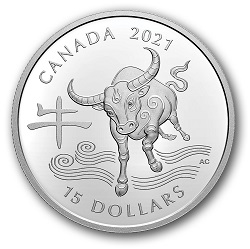
Face value: 15 dollars … Composition: 99.99% pure silver; Mintage (quantity produced): 15,888; Weight: 31.39 g; Diameter: 38 mm; Coin finish: Proof; Edge: serrated; Certificate: serialized; Artist: Aries Cheung (reverse), Susanna Blunt (obverse).
Design: Canadian artist Aries Cheung has created a stylized depiction of an Ox charging towards its Chinese character situated on the left side of the design. Beneath the Ox’s feet, dust swirls about like auspicious clouds, their swirling contours echoed in the Ox’s flank to bestow good fortune upon this zodiac sign. The obverse features the effigy of Her Majesty Queen Elizabeth II by Susanna Blunt.
Did you know… *** The Year of the Ox occurs every 12 years—1925, 1937, 1949, 1961, 1973, 1985, 1997, 2009—and now, 2021. However, the Chinese New Year shifts annually due to the Spring Festival, and this affects the zodiac for people born in January and February. For example, the Year of the Ox begins on February 12, 2021, and ends on January 30, 2022. *** Famous Canadian Ox people include: Oscar Peterson, Jim Carrey, Marc Garneau, Michael J. Fox, Eric Lindros, Roch Carrier, Frank Mahovlich, Neve Campbell and Paul Coffy. *** Ox people are strong and robust. They generally enjoy a long, full life with few health issues. *** Ox people thrive in careers that demand a strong work ethic and determination to get things done. They perform well in manufacturing, mechanics, pharmaceuticals, draftsmanship, politics, real estate, carpentry, engineering and agriculture. *** The practical, hard-working Ox will forge the strongest relationships with the Snake and Rooster. It will have difficulty trusting the Monkey’s scheming ways and will find the Sheep’s emotional sensitivity intolerable. *** Every Chinese zodiac rotates through the 5 elements (wood, fire, earth, metal, water). Metal Ox personalities born in 2021 will have an iron will and nerves of steel. They are reserved but will express themselves sharply and decisively when necessary.

2021 … $15 Pure Silver Coin
– Lunar Lotus: Year of the Ox
www.mint.ca www.canadapost.ca
Honour the special OX person in your life with this lotus-shaped pure silver coin celebrating the Year of the Ox. With a special mintage of 15,888, this beautiful coin features a mirror background that has been hand polished to add an impeccable shine to the meticulously engraved design. The coin reverse shows the powerful Ox gently bowing its head beneath a branch of peach blossoms to reveal its kind and benevolent nature. To the right, the Chinese character for “Ox” is engraved. The obverse features the effigy of Her Majesty Queen Elizabeth II by Susanna Blunt. The coin comes in a satin-like covered case with a custom red sleeve, perfect for gifting. The Year of the Ox begins on February 21, 2021. This unique coin is the 12th and final issue in this ongoing series honouring all 12 Chinese zodiacs, and a great addition to any collection of silver, zodiac, cultural or art-themed coins.
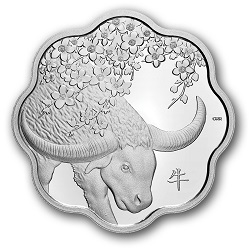
Face value: 15 dollars … Composition: 99.99% pure silver; Mintage (quantity produced): 15,888; Weight: 26.7 g; Diameter: 38 mm; Coin finish: Proof; Certificate: serialized; Artist: Three Degrees Creative Group (reverse), Susanna Blunt (obverse).
It’s the Year of the Ox for 2021, and anyone born after February 12th will be one of the most devoted individuals anyone would be blessed to know. The common expression “strong like an ox” isn’t just about physical strength; it also refers to the Ox’s mental fortitude. No matter how difficult a task may be, the Ox personality keeps going. While other zodiacs may rely on wit and cunning, the Ox achieves its goals through sheer tenacity and dedication. Its patience is legendary, but the quiet and introverted Ox will buck any injustice and take command if pushed too far. The Ox is fair-minded and a good listener, and will honour you with an unwavering bond. Cherish China’s most devoted zodiac with this captivating lotus-shaped coin.
Design: Canadian Three Degrees Creative Group has portrayed the powerful Ox gently bowing its head beneath a branch of peach blossoms to reveal its kind and benevolent nature. To the right, the Chinese character for “Ox” is engraved. The obverse features the effigy of Her Majesty Queen Elizabeth II by Susanna Blunt.
Did you know… *** The Year of the Ox occurs every 12 years—1925, 1937, 1949, 1961, 1973, 1985, 1997, 2009—and now, 2021. However, the Chinese New Year shifts annually due to the Spring Festival, and this affects the zodiac for people born in January and February. For example, the Year of the Ox begins on February 12, 2021, and ends on January 30, 2022. *** Famous Canadian Ox people include: Oscar Peterson, Jim Carrey, Marc Garneau, Michael J. Fox, Eric Lindros, Roch Carrier, Frank Mahovlich, Neve Campbell and Paul Coffy. *** Ox people are strong and robust. They generally enjoy a long, full life with few health issues. *** Ox people thrive in careers that demand a strong work ethic and determination to get things done. They perform well in manufacturing, mechanics, pharmaceuticals, draftsmanship, politics, real estate, carpentry, engineering and agriculture. *** The practical, hard-working Ox will forge the strongest relationships with the Snake and Rooster. It will have difficulty trusting the Monkey’s scheming ways and will find the Sheep’s emotional sensitivity intolerable. *** Every Chinese zodiac rotates through the 5 elements (wood, fire, earth, metal, water). Metal Ox personalities born in 2021 will have an iron will and nerves of steel. They are reserved but will express themselves sharply and decisively when necessary.

2020 … $10 Pure Silver Coin –
O Canada! Changing of the Guard
www.mint.ca
Celebrate O Canada with this stunning pure silver coin featuring one of the country’s most recognized military traditions and a popular summertime attraction in the nation’s capital: the Changing of the Guard. The fourth in the 6-coin O Canada! Series captures the pomp and musical pageantry of the ceremony, which takes place on Parliament Hill in Ottawa every morning from late June to late August. Designed by Canadian artist Pandora Young, the reverse is a front view of the Changing of the Guard ceremony in Ottawa, Ont., where the Band of the Ceremonial Guard leads the procession. The reverse includes the curve text “CANADA” above a maple flourish and the year “2020”. The obverse features the effigy of Her Majesty Queen Elizabeth II by Susanna Blunt. Every coin in this series is designed by a different Canadian artist for a different take on some of the most famous images of Canada.

Face value: 10 dollars … Composition: 99.99% pure silver;
Mintage: 10,000; Finish: matte proof;
Weight: 15.87 g; Diameter: 34 mm; Edge: serrated;
Artist: Pandora Young (reverse), Susanna Blunt (obverse).
It is one of Canada’s most recognized military traditions and a popular summertime attraction in the nation’s capital! Every morning from late June to late August, the Changing of the Guard ceremony brings pomp and musical pageantry to Parliament Hill in Ottawa, Ont. Dressed in scarlet tunics and tall bearskin hats, the Ceremonial Guard performs colourful drills and marches to the sounds of the regimental band, which leads the way on this fine silver coin. Our O Canada! series continues! Coin #4 gives you the best view of the Changing of the Guard ceremony, which is one of six iconic images of Canada in 2020.
Design: Designed by Canadian artist Pandora Young, the reverse is a front view of the Changing of the Guard ceremony in Ottawa, Ont., where the Band of the Ceremonial Guard leads the procession. The reverse includes the curve text “CANADA” above a maple flourish and the year “2020”. The obverse features the effigy of Her Majesty Queen Elizabeth II by Susanna Blunt.
“I see this ceremony as a celebration of Canada, and the drive felt by these men and women to execute a perfect performance comes from their love for our Canadian family.” Pandora Young: Artist.
“The members of the Band of the Ceremonial Guard are instantly recognizable with their distinctive red tunics and bearskin hats. The band performs the famous Changing of the Guard Ceremony on the lawns of Parliament Hill during the summer, an iconic Canadian military tradition.” Master Warrant Officer Michel Simard, Ceremonial Guard Band Sergeant-Major: The Expert.
Did you know… *** The first Guard Mount on Parliament Hill took place on July 2, 1959. *** In addition to the ceremony on Parliament Hill, the Ceremonial Guard also performs sentry duties at the Tomb of the Unknown Soldier and at Rideau Hall, the official residence of the Governor-General of Canada. *** The Ceremonial Guard is comprised of members of the Canadian Armed Forces. They uphold the customs and traditions of two Guards regiments, the Governor General’s Foot Guards (GGFG) and the Canadian Grenadier Guards (CGG). If you see them in person, look closely at the colour of the plume in the bearskin hat: a red plume represents the GGFG while a white one represents the CGG. *** The bearskin hats worn by Canada’s Ceremonial Guard are carefully maintained and are all more than 20 years old!

2020 … Pure Gold Coin – Dominion of Canada
www.mint.ca
It was 150 years ago that a newly minted country issued its first coins. To mark this anniversary, Leonard C. Wyon’s historic maple bough design has been brought back to life on a limited $10 commemorative piece that proudly pays tribute to Canada’s first national coinage.
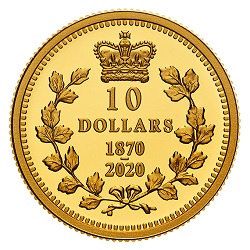
Face value: 10 dollars … Composition: 99.99% pure gold;
Mintage: 1,000; Finish: proof; Diameter: 20 mm;
Weight: 7.8 g; Edge: serrated; Certificate: serialized;
Artist: Leonard Charles Wyon (reverse),
Susanna Blunt (obverse).
Design: Double dated (“1870 – 2020”) to commemorate the 150th anniversary of Canada’s first national coinage, the reverse is a reproduction of Leonard C. Wyon’s crossed maple boughs design surmounted by St. Edward’s Crown, as seen on the four denominations (5, 10, 25 and 50 cents) of coins issued by the Dominion of Canada in 1870. The obverse features the “laureate” effigy of Queen Victoria by Leonard C. Wyon, as it appeared on the historic 5- and 10-cent coins.
Did you know… Seen on this coin’s obverse, Leonard C. Wyon’s portrait of Queen Victoria was inspired by the “Young Head” effigy (1838-1895) designed by his father, William Wyon (1795-1851), former Chief Engraver at The Royal Mint. The maple bough arrangement looks symmetrical but it actually has 21 leaves: 11 on the left and 10 on the right. A 22-leaf wreath was introduced in 1882.

2021 … $1 Pure Silver Coin – Peace Dollar
www.mint.ca
Celebrate Canada’s legacy as a nation of peace with the 2021 Peace Dollar! Our nation is widely known for its dedication to peace, and that commitment – as well as its legacy – has been handed down and cherished by each new generation of Canadians. This coin is a soaring celebration of peace thanks to ultra-high relief engraving, which lifts the design to new heights while giving it extra depth and lustre.
The reverse design features the profile of Lady Peace, crowned with maple leaves. Her visage is accompanied by “PAX 2021” and Canada’s national motto “A MARI USQUE AD MARE” (From Sea to Sea). The coin also bears edge lettering with the Latin word “PAX”, which means peace. The obverse features the effigy of Her Majesty Queen Elizabeth II by Susanna Blunt. A stunning reverse proof finish puts the spotlight squarely on the brilliant relief, which looks extra-luminous against a matte field.
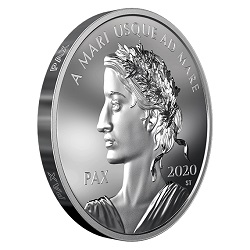
Face value: 1 dollar … Composition: 99.99% pure silver;
Mintage: 5,000; Finish: Reverse proof; Certificate: serialized;
Weight: 30.76 g; Diameter: 36.15 mm; Edge: plain;
Artist: Susan Taylor (reverse), Susanna Blunt (obverse).
Our nation is widely known for its dedication to peace, and that commitment – as well as its legacy – has been handed down and cherished by each new generation of Canadians. It was Canadian Lester B. Pearson who, in his capacity as Canadian Secretary of State for External Affairs, organized the very first UN peacekeeping force in 1957. His efforts earned him a Nobel Peace Prize and helped cement Canada’s reputation as both a peacekeeping and peace-loving nation. That vision holds true today, as Canada continues to advocate for peace and freedom the world over.
Design: The reverse design features the profile of Lady Peace, crowned with maple leaves. Her visage is accompanied by “PAX 2021” and Canada’s national motto “A MARI USQUE AD MARE” (From Sea to Sea). The coin also bears edge lettering with the Latin word “PAX”, which means peace. The obverse features the effigy of Her Majesty Queen Elizabeth II by Susanna Blunt.
Did you know… *** It was 100 years ago, in 1921, that the U.S. Mint issued the first Peace Dollar. It was designed by Anthony de Francisci and struck as a .900 fine silver coin to celebrate peace after the First World War. *** Lester B. Pearson wasn’t the only one to receive the Nobel Peace Prize for his peacekeeping efforts. In 1988, thousands of Canadians were among the peacekeepers of the world who were collectively awarded for their service in UN missions. *** The 1988 Nobel Peace Prize inspired Canada to establish our own Canadian Peacekeeping Service Medal (CPSM), now proudly worn by many veterans.

2021 … Pure Gold Coin – Peace Dollar
www.mint.ca
Our nation is widely known for its dedication to peace, and that commitment – as well as its legacy – has been handed down and cherished by each new generation of Canadians. It was Canadian Lester B. Pearson who, in his capacity as Canadian Secretary of State for External Affairs, organized the very first UN peacekeeping force in 1957. His efforts earned him a Nobel Peace Prize and helped cement Canada’s reputation as both a peacekeeping and peace-loving nation. That vision holds true today, as Canada continues to advocate for peace and freedom the world over.
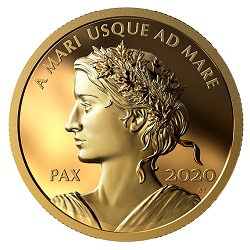
Face value: 200 dollars … Composition: 99.99% pure gold;
Mintage: 500; Finish: Reverse proof; Certificate: serialized;
Weight: 31.16 g; Diameter: 30 mm; Edge: interrupted serrations;
Artist: Susan Taylor (reverse), Susanna Blunt (obverse).
Design: The reverse design features the profile of Lady Peace, crowned with maple leaves. Her visage is accompanied by “PAX 2021” and Canada’s national motto “A MARI USQUE AD MARE” (From Sea to Sea). The coin also bears edge lettering with the Latin word “PAX”, which means peace. The obverse features the effigy of Her Majesty Queen Elizabeth II by Susanna Blunt.
Did you know… *** It was 100 years ago, in 1921, that the U.S. Mint issued the first Peace Dollar. It was designed by Anthony de Francisci and struck as a .900 fine silver coin to celebrate peace after the First World War. *** Lester B. Pearson wasn’t the only one to receive the Nobel Peace Prize for his peacekeeping efforts. In 1988, thousands of Canadians were among the peacekeepers of the world who were collectively awarded for their service in UN missions. *** The 1988 Nobel Peace Prize inspired Canada to establish our own Canadian Peacekeeping Service Medal (CPSM), now proudly worn by many veterans.

2021 … $200 Pure Gold Coin – The Classical Maple Leaf
www.mint.ca
The precision-engraved details of the Gold Maple Leaf (GML) bullion coin shine with renewed splendour against this coin’s frosted field and mirror-like lattice pattern. It’s a sophisticated maple-themed celebration, and a timely one at that, given that 2021 marks the 25th anniversary of the maple’s designation as Canada’s national arboreal emblem.
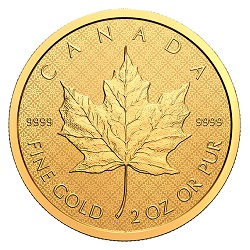
Face value: 200 dollars … Composition: 99.99% pure gold;
Mintage: 175; Finish: reverse proof; Weight: 62.34 g;
Diameter: 42 mm; Edge: serrated;
Certificate: serialized; Artist: Susanna Blunt (obverse).
Design: The reverse is based on the Royal Canadian Mint’s iconic Gold Maple Leaf (GML) bullion coin and features its classically styled portrait of a maple leaf. Paired with the coin’s reverse proof finish, a micro laser-engraved lattice field pattern adds a light-refracting design element to the reverse and the obverse, which features the effigy of Her Majesty Queen Elizabeth II by Susanna Blunt.
Did you know… In 1982, the Royal Canadian Mint produced the world’s first 99.99% pure gold bullion coin, which featured the same maple leaf seen here.


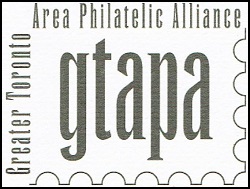
www.gtapa.org
The GTAPA is committed to promote and
stimulate the art of philately to all ages
for fun, culture, education, and friendship.




